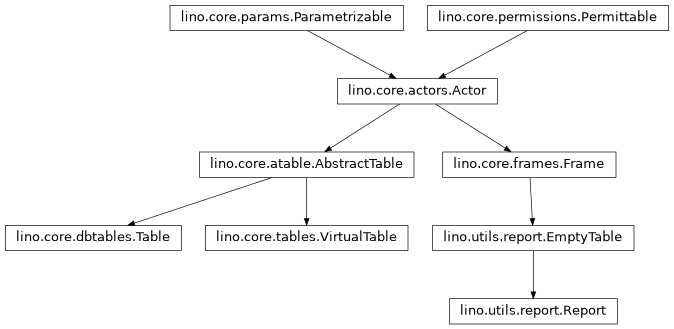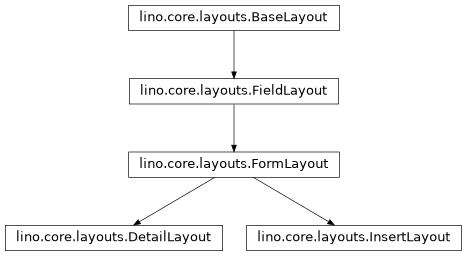Monday, September 28, 2015¶
Fixed a bug in atelier¶
Yet another bug in atelier: #553. Congratulations to Hamza who stumbled over this:
The fab bd command failed to call load_fabfile when trying to write the
README.rst file. This didn’t disturb anybody until now because I
have a ~/.atelier/config.py file (and when you have such a
file, all projects are automatically loaded, including
load_fabfile.
Inheritance diagrams¶
While testing above change I rediscovered the Sphinx can generate inheritance diagrams (see 2015-06-29).
Here are some diagrams that might be interesting for Sandeep:
Actors:

Layouts:

The pp command¶
I discovered that the pp script (installed with atelier
is not yet documented. TODO: move /scripts to /atelier/scripts
and add it to the API.
Restarted tim2lino¶
I finally continued to work on #353. This time we have a much
more pleasant general structure because accounting has been moved from
lino.modlib to lino_cosi.lib.
The new plugin lino_cosi.lib.tim2lino defines no models, no
actors and no menu commands, but a fixture (in
lino_cosi.lib.tim2lino.fixtures.tim2demo).
This fixture was in lino_presto until now. Next step is to
modularize tim2lino. Because e.g. a simple Così customer like cosi1 or
fijal is not interested in importing households or calendar entries,
but some future customers like spz or myself will want them.
Release in Eupen¶
For the first time I had the situation that a customer wants to upgrade to the version “which they have been testing during a week” and not to “the latest available version”.
Environment “testlino” becomes the environment for their production site (despite the name), and I created a new environment “a” for their testing site (which is named “testlino”).
From now on I plan to name environments simply “a”, “b”, “c” …
because virtual environments cannot be renamed, and because a given
environment is normally first used for testing and then for
production. I can then easily switching between environments because
Lino, Django and Apache activates them using the symbolic link
env in their proect directory.
When upgrading their testlino env to the newest development version (which now requires lxml), the first attempt of my trick from Tuesday, September 22, 2015 failed:
$ sudo apt-get build-dep lxml
[sudo] password for lsaffre:
Reading package lists... Done
Building dependency tree
Reading state information... Done
E: You must put some 'source' URIs in your sources.list
So I added a deb-src line to /etc/apt/sources.list and did
sudo apt-get update. Now it works:
$ sudo apt-get build-dep lxml
Reading package lists... Done
Building dependency tree
Reading state information... Done
The following NEW packages will be installed:
debhelper gettext gettext-base intltool-debian libasprintf0c2 libcroco3 libpython-all-dbg libpython-all-dev libpython-dbg libpython2.7-dbg libpython3-all-dbg
libpython3-all-dev libpython3-dbg libpython3-dev libpython3.4 libpython3.4-dbg libpython3.4-dev libunistring0 libxml2-dev libxslt1-dev po-debconf python-all
python-all-dbg python-all-dev python-dbg python-pyrex python2.7-dbg python3-all python3-all-dbg python3-all-dev python3-dbg python3-dev python3-setuptools
python3.4-dbg python3.4-dev
0 upgraded, 35 newly installed, 0 to remove and 75 not upgraded.
Need to get 69.4 MB of archives.
After this operation, 190 MB of additional disk space will be used.
Do you want to continue? [Y/n]
A cool trick: I added an alias to my .bash_aliases:
alias a='. env/bin/activate'
I also invented the trick of having the following line in the
settings.py of all sites:
STATIC_ROOT = SITE.project_dir.child(‘env’, ‘collectstatic’).resolve()
I updated the /admin/using page of the Administrator Guide with today’s findings.
User’s guide, Users’ guide or User guide?¶
The Lino documentation has three “guides”:
one for application developers
one for system administrators
one for end-users
English is not my native language, but here are some linguistical thoughts. I discovered that the apostrophe seems to be disappearing. Wikipedia removes them shamelessly in articles like User guide and a Tourist guide.
But I don’t agree. An “Installation guide” would be without apostrophe because it is a guide about installation. But our three guides are not about developers, administrators and users, they are written for these people. A linguistic evolution does not become good just because many people are stupid enough to follow it.
So I continue to use an apostrophe. Another question is where to put the apostrophe. I read the discussion User’s Guide vs Users’ Guide, and my opinion is that indeed both forms are valid. It is true that the reader is always only one person (i.e. User’s guide), but it is also true that I as the author write it for many users (and thus I can call it a Users’ guide). So the place of the apostrophe is a question of style or taste.
I still prefer the singular form. My main argument is that users, administrators and developers will almost certainly never read these documents when they are together with other users, adminstrators or developers. (It is difficult enough to get them to read it when they are alone!)
Here is another place where Jonathan Leffler calls it “probably the best choice”.
And if you have difficulties to remember this choice, then I recommend reading The Hitchhiker’s Guide to the Galaxy …